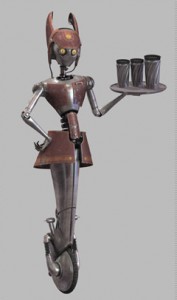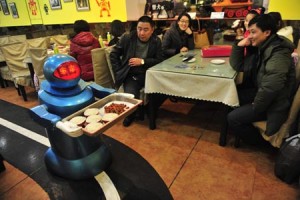
The Star Wars cantina scene demonstrates how awesome it would be to sidle up to a bar (preferably on some kind of bounty hunting mission) and order a drink from aliens. Attack of the Clones features a robot waitress, which was probably the best thing about that movie. While we know of no ETs willing to serve up nightcaps or flip burgers, robot waiters are no longer science fiction.

In Harbin, China, robots that resemble Daleks wait tables, cook meals, and seat diners. At the Robot Restaurant, diners are greeted by a robot host who says, “Earth Person, Hello.” In the kitchen, robots whip up dumplings and noodles and then robot waiters bring them to the tables via conveyor belts in the floor. As if that’s not enough, robots entertain diners with songs.

In the Dalu Robot Restaurant in Jinan, China’s first robot eatery, the robots more closely resemble Star Wars droids. They circle the dining room on a conveyor belt with a cart loaded with food, serving up up dishes dim-sum style. They stop when their sensors detect someone reaching for food. These robots cost about $6,000 each, not including consistent operating and upkeep costs. Other robot waiters cost tens of thousands of dollars.
Similar robo-restaurants can be found in Japan, South Korea, Hong Kong, and Thailand. Some of these robots can respond to basic voice commands (which is more than some human waiters do), but most take orders via touch screens.
While this technology may seem novel and impressive, it has its detractors. The head of Duke University’s Robotics Laboratory dismissed these robo-waiters, calling them “really just a conveyor belt, bringing food from the kitchen, with lots of bells and whistles.” But people love bells and whistles! And people love robots—especially when they’ve got food.

Now, the trend has caught on in the Western World. A sushi chain in London, which has already incorporated robot drink carts and conveyor belts, now uses drones to deliver food to tables. Unlike the Chinese restaurants, the iTray flies and is controlled by an iPad. The iTray can move at 25 miles an hour, though that seems a bit risky if it’s loaded with food and drinks. While this one isn’t a conveyor belt, it does require people to take their order off the tray. It doesn’t mind being ogled, though.
Scientists predict that as AI develops, robo-waiters will become more conversant, engaging diners in ways only the most adroit waitstaff can. What’s more, they’ll never complain if you return the food or decide to order an omelette with sixteen ingredients. Right now, these robots are pricier than their human counter-parts, even though they don’t expect tips. But as the production costs go down, they may end up saving restaurateurs money. They’ll never request vacations or holiday pay and they’ll never need health insurance or file a worker’s comp claim.
But before we get too comfortable with the notion of complaint and uncomplaining wait staff, we should consider that someday they could become aware enough to unionize or rebel for lack of tips. And who knows what they’ll do once they realize how crappy the gratuities are.
